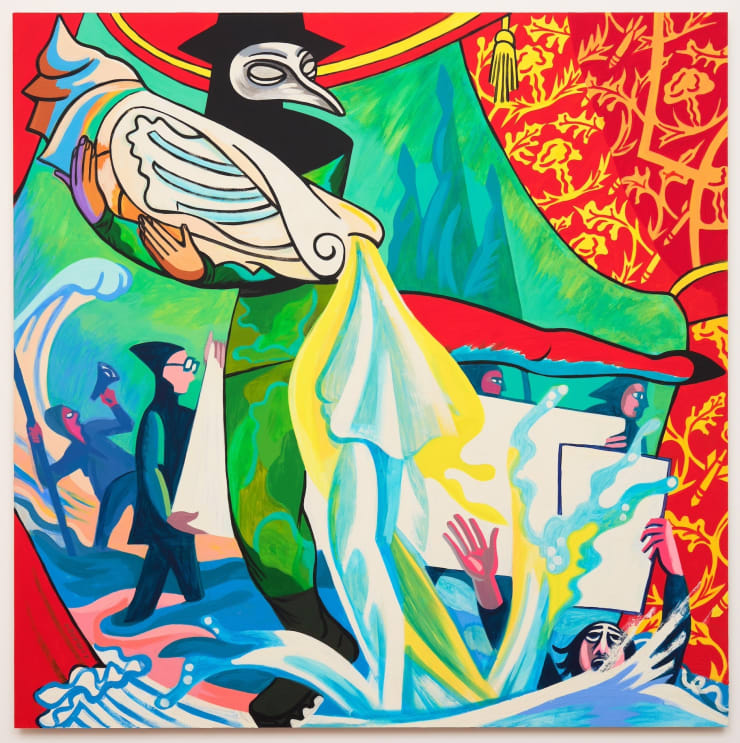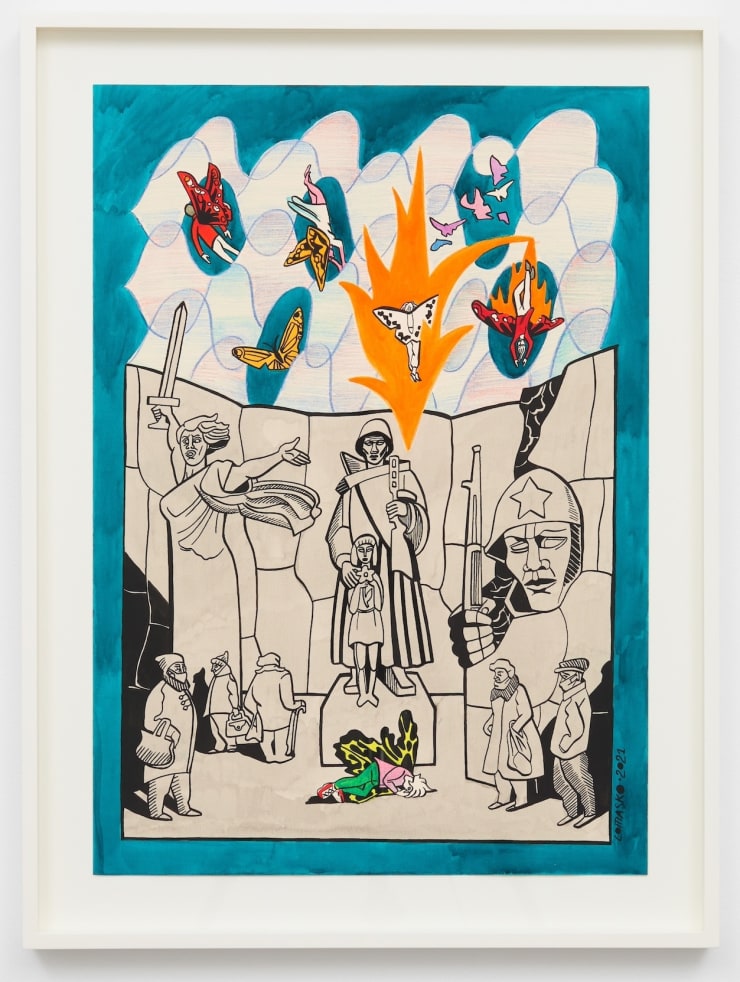Victoria Lomasko: Cocoon
Opening reception | Thursday 2 November 6-8pm
What does the face of history look like? Not in books or in movies or other countries' news reports, but when history opens the door of your house and comes in, destroying everything in its path. - Victoria Lomasko
Edel Assanti is pleased to present Cocoon, Victoria Lomasko's second solo exhibition at the gallery. The show coincides with the artist's solo exhibition at Kunsthaus Göttingen, Germany, and follows her survey exhibition at Santa Giulia Museum, Brescia, Italy, The Last Soviet Artist (2022-23).
Lomasko gained international acclaim with the publication of her seminal graphic novel Other Russias, published in seven languages since 2017. In the ensuing years, Lomasko's practice evolved from politicised graphic-reportage to a form of poetic realism, expanding her output to monumental murals and paintings on panel. Synthesising the iconography and legible symbolism of Socialist Realism, images of Lomasko's distinctive artistic language narrates frontline histories of conflict within a patchwork of dreamlike biographical narratives, allowing her to confront and visualise personal experiences in the face of a turbulent socio-political landscape.
Cocoon presents five new paintings, a drawing and a site-specific mural created since the outbreak of the Russia-Ukraine war, a period that Lomasko has spent working in exile in Europe, whilst becoming an increasingly prominent dissident voice. Shown for the first time in the UK, the series amalgamates charged political and historical symbolism with autobiographical references to reflect on the imperatives of the artist's role in her situation. In Lomasko's words: "My aim is to see the transformation beyond the catastrophe. Something new is emerging from this horrific chrysalis. It is a new reality."
The show unfolds in three acts: Past, Present and Future, during which Lomasko's artistic, philosophical and social concerns are played out by a cast of fantastical and real-life characters. The earliest work in the presentation opens the show: Butterflies Aflutter (2021) displays a striking prescience of both the rupture of the war in Ukraine and the subsequent ideological collapse. Rendered in watercolour and ink on paper, the drawing shows figures with kaleidoscopic butterfly wings struggling to maintain elevation above a series of Soviet monuments. Two butterflies have burst into flames; one lays unmoving on the ground. The rigid military sculptures, laden with the task of relaying the revolutionary utopian vision to common citizens, stand in stark contrast with the powerless butterfly beneath, his still figure the embodiment of a young Russian generation flapping through the ruins of post-Soviet reality.
In an arresting circular canvas, Caryatids Drop the Sky (2023), a pair of female figures take the form of caryatids, architectural features that often replaced columns or pillars in Ancient Greece, and find themselves struggling to support the cascading sky. This oneiric vision is bisected by the ghostly, white outline of a military plane. This abstract form, the god of war, a crucifix by design, rules the composition, connecting left and right sides of the canvas, and links us to the Present moment.
The tryptic Favourite (2023) considers the struggle faced by artists to retain an authentic voice in an ever-changing world. In the panel on the left we see Russian artists, who in response to the contemporary political climate feel pressure to become "artist-activists". On the right, we see the figure of the artist in the West, who must fight like a matador to preserve his unique creative vision in the era of late capitalism. The central panel opens up a speculative third space, one in which the artist is raised above history, politics and economic systems, and is free to create and take risks. Lomasko observes: "Earlier I thought that in the wind of history an artist must be a hero, and the heroic figure was incredibly important to me. But now, I don't see any other heroes except history."
Cocoon reaches its climax with the exhibition's eponymous painting. An onrush of colours - red, gold, black and blue - emerge as a swirling dance from behind a stage curtain, while a parade of protestors carry blank banners as a symbol of undetermined transformation. From the Cocoon emerges a scene of defiance against destructive power, offering a prised-open space in which to shape a different Future.










